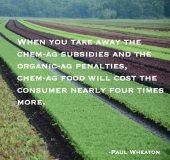In general, those number seem very high. For example, in the United States Americans spend about
$50 billion a month in grocery stores. Based on
this article "by 2014, the U.S. was on target to spend $972.9 billion on food and farm programs over the next decade." That works out to $8 billion a month on food and farm subsidies with food stamps accounting for
$6.5 billion of that monthly total. While the $1.5 billion in monthly non-food stamp subsidy money certainly does have some impact on the $50 billion in total grocery store sales, I doubt removing it would suddenly cause conventional food to be four times more expensive.
That being said, I'm sure there is some specific example of some product out there where the conventional version would be four times the cost of organic without the subsidies. Paul is probably referring to that example, and whether or not that one specific example applies to the totality of U.S. food production is debatable.









